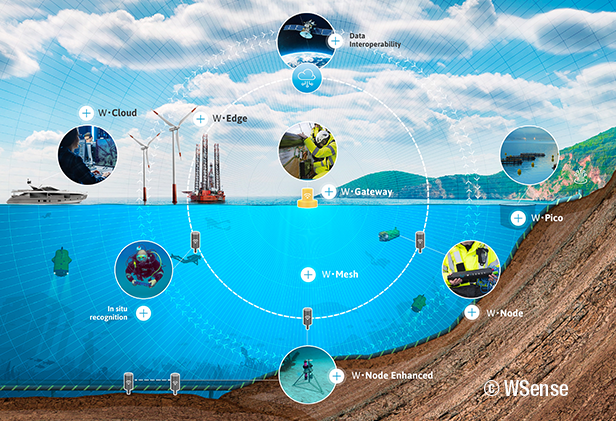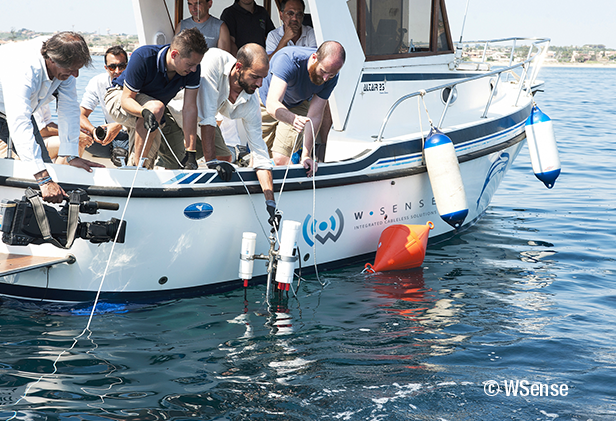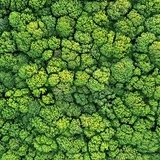Network for the big blue
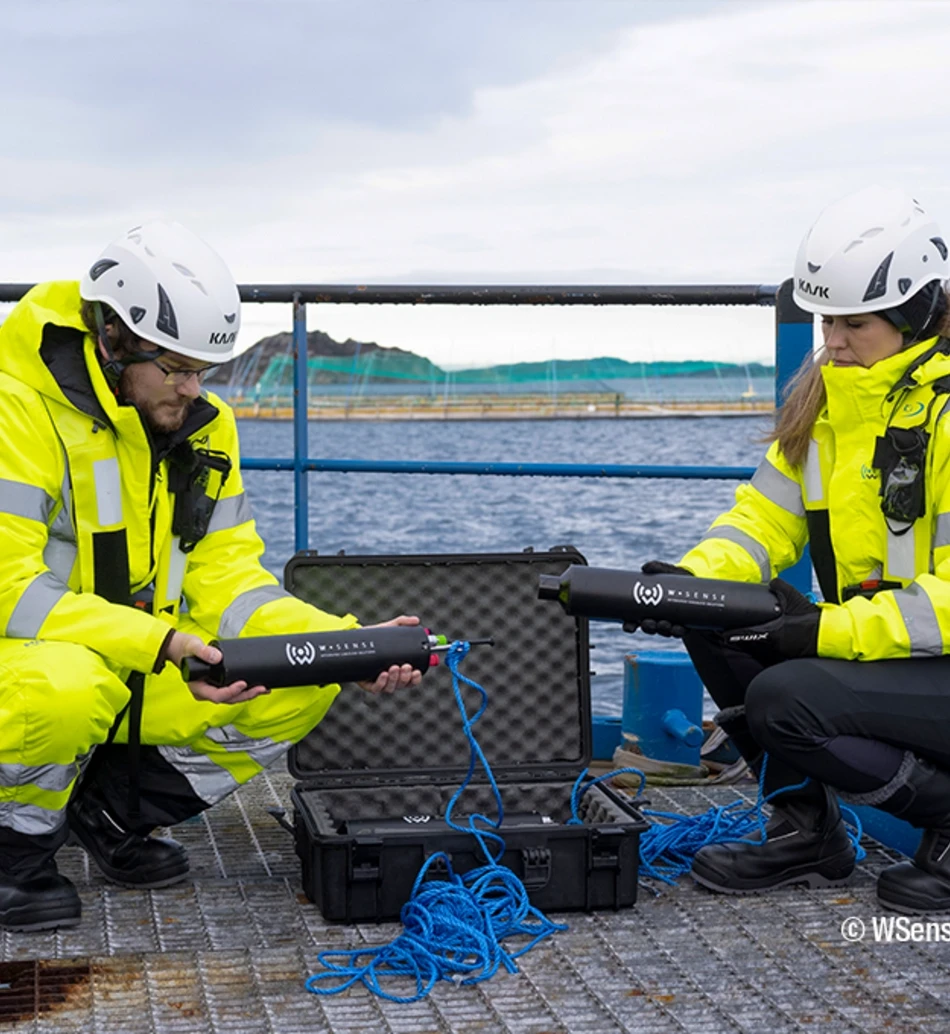
大海原のためのネットワーク
前回の世界経済フォーラムで表彰されたイタリアの新興企業WSenseは、水中無線通信のソリューションとなりうるプラットフォームを開発しています。
このプラットフォームは、地球の研究と理解に革命をもたらす可能性があります。CEOのキアラ・ペトリオリ氏にインタビューしました。
科学はデータによって発展します。そのため、モノのインターネット(IoT)の登場は素晴らしい革命をもたらしました。数十億のセンサーを搭載した「知的オブジェクト」が互いに、サーバーに接続され、リアルタイムで膨大なデータを収集し、交換しています。これらのデータは分析され、世界中でアクセス可能で共有可能となり、研究者はこれまでにない方法で地球を観察し、理解することができるようになりました。
さて、私たちの地球全体がそうではありません。IoTは海や大洋とはつながっていません。
この盲点はかなり厄介です。水は地球の表面の72%を覆い、その体積は生物多様性の80%を収容し、気候変動などの地球規模の現象に重要な役割を果たしています。海洋を統合せずにグローバルなビジョンを主張することは不可能です。
海洋調査ステーションは世界中に点在しています(藻屑となった針のように)。また、インテリジェントな海洋物体(センサー、ブイ、自律走行車、プローブ...)も増えつつあります。水中無線ネットワークの基盤も構築されており、IoTと同様にアクセスしやすく信頼性の高い 「Internet of underwater things」(IoUT)となるはずです。この分野のパイオニアであるイタリアのWSense社は、今年好調な流れを見せています。
このスタートアップの冒険は、ローマのサピエンツァ大学キアラ・ペトリオリ教授が研究室を担当しているところから始まりました。「私たちは10年前に水中ネットワークの研究を始めました。私たちは、ルーターのような要素を使って、広いエリアで情報を確実に伝送する方法を見つけたかったのです。」この研究結果は、以前には不可能だったレベルの信頼性と性能を達成するソリューションが生まれ、いくつかの国際特許が出願されました。WSenseは、音響学、ネットワーク・アーキテクチャ、信号処理などの分野の博士号取得者とエンジニアで2017年に設立されました。
現在、この新興企業はイタリア、イギリス、ノルウェーにオフィスを構え、50人のスタッフを擁しています。顧客はブルーエコノミー企業や科学機関など約20社です。同社のイノベーションは、2022年に欧州技術革新協会のデジタル・チャレンジ賞と欧州委員会のブルーインベスト賞を受賞しました。
ご想像の通り、「ワイヤレス・ネットワーク 」と 「水中 」は相性がよくありません。実際、空中でWiFiを機能させるものは水中では機能しません。電波は著しく減衰し、光や音の通信は温度、塩分濃度、バックグラウンドノイズによって大きく変化します。すべてを再考する必要があり、WSenseはまさにそれを行いました。
このソリューションは、中距離用の音響通信と近距離用の光LED技術の革新的な組み合わせに基づいており、人工知能のヒントが隠されています。
具体的には、水中に「ノード」が配置されます。ノード間のデータ転送はAIによって常に最適化され、海の状況が変化するたびに、アルゴリズムがバイト・パケットがたどる経路を変更します。
キアラ・ペトリオリ氏によれば、このシステムは1kbit/sの速度で1000mまでデータを送ることができ、それより短い距離では数Mbit/sで送ることができます。もちろん、この帯域幅は空中ネットワークとは異なりますがこれを拡大するために取り組んでいます。しかし、センサーが収集した環境データを送信するには十分です。
生成されるネットワークは安定性があり、信頼性が高く、オープンです。様々なタイプやブランドの複数のデバイス(センサー、プローブ、車両)を接続することができます。WSenseは、まず浅瀬(水深300mまで)用にプラットフォームを設計しましたが、現在では水深3,000mまで使用可能で、海洋への扉をより大きく開いています。
水面上では、フローティングゲートウェイ(または近くの陸地に設置されたもの)がこのローカルネットワークを『クラウド』に接続し、世界の他の部分とつながります。こうして、IoUT(Internet of Underwater Things)はIoTに統合されます。
WSenseは、ノード、プローブ、モデム、ゲートウェイなど、必要なハードウェアだけでなく、すべてのソフトウェア(ネットワークソフトウェアからデータ処理まで)を自社で設計しています。
ちなみに、独自の装置にはセンサーが満載です。「温度、塩分、pH、クロロフィル、メタン、アンモニウム、リン酸塩、CO2、波浪、潮汐、バックグラウンドノイズ......」一言で言えば、海底環境をリアルタイムで追跡調査し、広範囲に監視するために必要なものすべてです。
養殖業は、Wsenseに興味を示した最初のセクターのひとつです(現在も主要な顧客です)。飼育ケージをカバーするワイヤレス・ネットワークの導入により、かさばるケーブル配線が不要になり、ビオトープの監視や養殖場の制御に必要なあらゆるものが接続されます。カメラやセンサー、そしてロボットです。
An out-of-the-box diving experience
This summer, WSense will launch a miniature device : a “ micronode ” which could considerably enhance our submarine diving experience, just like smartphone applications have contributed to enriching our daily lives.
The size of a pack of cigarettes, the device is linked by cable (and LEMO W Series connectors) to a watertight tablet. Thanks to the solution, divers can communicate with the surface and among each other much better than by sign language.
“ It also makes it possible for them to receive real-time information about what they see around themselves ”, explains Chiara Petroli. For the submerged Roman ruins of Baiae for instance, the tablet could show, in augmented reality, the reconstituted buildings visited by “ diving tourists ”.
In addition, the “ micronode ” is equipped with a GPS, “ which increases safety, since the divers will always be precisely located. This option also opens new ways of exploring archaeological sites. It will be possible, for instance, to guide visitors along pre-defined itineraries. There are endless possibilities ! ”
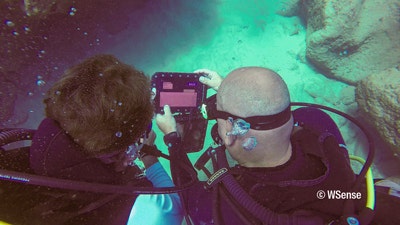
This new product will be presented during the finish of the prestigious “ Ocean Race ” (a round-the-world sailing challenge) which will be held late June in Genoa (Italy).
“ We are in the process of developing autonomous robotic systems ”, explains Doctor Petrioli. “ We can allow teams of robots to communicate and collaborate, to send data, get instructions and change their mission in real time. ”
Following a request from a Norwegian customer, WSense R&D has recently developed an ultra-miniature fish wearable element. It makes it possible to closely observe the life and health of animals, whilst monitoring water quality. “ All this goes in the same direction : supplying tools to go further in the direction of a more sustainable fish farming. ”
Similarly, WSense’s platform can make it considerably easier to survey and work around off-shore stations, as well as underwater infrastructures, such as gas and oil pipelines.
It is just as efficient in more natural environments. The startup has deployed its network in sensitive sites and environmental hotspots. Scientists use it for instance for studying how algae, corals and animals adapt to climate change. In the field and continuously, “ which is much more precise than what we could do from the surface or satellites. ” The solution also monitors sites that represent major risks for human populations, such as volcanic areas.
The WSense platform is also deployed in archeological or cultural sites, such as the submerged luxurious Roman city of Baiae, near Naples (Italy), which is part of the UNESCO World Heritage Sites. By measuring pollution and the effects of climate change or potential damage caused by visitors, it contributes to their protection the same way as it has for a long time in the case of on-land archeological sites.
Just like webcams placed around the world, “ those connected by WSense can also promote these sites. ” They open windows for education and tourism, providing access to a larger audience than that of just scientists, companies or authorities.
The startup is also about to launch a “ micronode ” which, connected to a watertight tablet, would enhance the diving experience (see opposite page).
This new appealing product does not really embody WSense’s true ambitions. The Italian company does not only offer, unlike others, “ smart devices ”. It doesn’t want to be just one more component in our already too fragmented knowledge of oceans.
On the contrary, it wants to unite all the components.
With this in mind, WSense has ensured the interoperability of its submarine network. For the same reason, it has also been working hard on making deployment simple and reducing costs, both prerequisites for its true purpose : to define the standard for IoUT.
For this purpose, WSense must enhance its notoriety as well as its platform. In January, it got a great boost from a place that hasn’t seen any oceans for the last 200 million years : Davos, in the heart of the Swiss Alps.
During its last edition, the prestigious World Economic Forum (WEF) rewarded ten companies, including WSense, winner of its Ocean Data Challenge, an event for identifying the most promising technologies in data collection and management for ocean protection. The reward gives access to the WEF network, an ideal platform for finding people who could give support for global scale up.
There was an immediate effect : WSense spent the following weeks answering a flood of inquiries.
“ It was huge ”, says Chiara Petrioli. “ We were able to talk to political and scientific leaders, top managers, who were often unaware of the possibilities. We could explain to them that the Internet of Underwater Things was not deep tech, but a solution ready to be implemented. ”
Quick positioning on the submarine communications market is quite interesting (Forbes estimated it at 3.5 billion dollars, with a 22% increase per year). However, urgency lies elsewhere, insists Chiara Petrioli.
“ We cannot delay applying these solutions. We must not go on ignoring so many things about the exploitation of the oceans or climate change. We must understand today, because it may be too late tomorrow. ”
